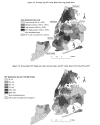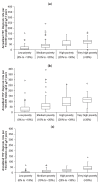The Association Between Neighborhood Poverty and HIV Diagnoses Among Males and Females in New York City, 2010-2011
- PMID: 26957664
- PMCID: PMC4765978
- DOI: 10.1177/003335491613100213
The Association Between Neighborhood Poverty and HIV Diagnoses Among Males and Females in New York City, 2010-2011
Abstract
Objective: We assessed the association of neighborhood poverty with HIV diagnosis rates for males and females in New York City.
Methods: We calculated annual HIV diagnosis rates by ZIP Code, sex, and neighborhood poverty level using 2010-2011 New York City (NYC) HIV surveillance data and data from the U.S. Census 2010 and American Community Survey 2007-2011. Neighborhood poverty levels were percentage of residents in a ZIP Code with incomes below the federal poverty threshold, categorized as 0%-<10% (low poverty), 10%-<20% (medium poverty), 20%-<30% (high poverty), and 30%-100% (very high poverty). We used sex-stratified negative binomial regression models to measure the association between neighborhood-level poverty and HIV diagnosis rates, controlling for neighborhood-level education, race/ethnicity, age, and percentage of men who have sex with men.
Results: In 2010-2011, 6,184 people were newly diagnosed with HIV. Median diagnosis rates per 100,000 population increased by neighborhood poverty level overall (13.7, 34.3, 50.6, and 75.6 for low-, medium-, high-, and very high-poverty ZIP Codes, respectively), for males, and for females. In regression models, higher neighborhood poverty remained associated with higher diagnosis rates among males (adjusted rate ratio [ARR] = 1.63, 95% confidence interval [CI] 1.34, 1.97) and females (ARR=2.14, 95% CI 1.46, 3.14) for very high- vs. low-poverty ZIP Codes.
Conclusion: Living in very high- vs. low-poverty urban neighborhoods was associated with increased HIV diagnosis rates. After controlling for other factors, the association between poverty and diagnosis rates was stronger among females than among males. Alleviating poverty may help decrease HIV-related disparities.
Figures



Similar articles
-
Neighborhood Characteristics Associated with Achievement and Maintenance of HIV Viral Suppression Among Persons Newly Diagnosed with HIV in New York City.AIDS Behav. 2017 Dec;21(12):3557-3566. doi: 10.1007/s10461-017-1700-2. AIDS Behav. 2017. PMID: 28160107
-
Racial and socioeconomic disparities in viral suppression among persons living with HIV in New York City.Ann Epidemiol. 2017 May;27(5):335-341. doi: 10.1016/j.annepidem.2017.04.005. Epub 2017 Apr 27. Ann Epidemiol. 2017. PMID: 28511865
-
Where you live can impact your cancer risk: a look at multiple myeloma in New York City.Ann Epidemiol. 2020 Aug;48:43-50.e4. doi: 10.1016/j.annepidem.2020.05.005. Epub 2020 May 15. Ann Epidemiol. 2020. PMID: 32620423
-
Sex- and Poverty-Specific Patterns in Cardiovascular Disease Mortality Associated With Human Immunodeficiency Virus, New York City, 2007-2017.Clin Infect Dis. 2020 Jul 27;71(3):491-498. doi: 10.1093/cid/ciz852. Clin Infect Dis. 2020. PMID: 31504325 Free PMC article.
-
Personal and neighborhood socioeconomic status and indices of neighborhood walk-ability predict body mass index in New York City.Soc Sci Med. 2008 Dec;67(12):1951-8. doi: 10.1016/j.socscimed.2008.09.036. Epub 2008 Oct 25. Soc Sci Med. 2008. PMID: 18954927 Free PMC article.
Cited by
-
Site-Based and Digital Cohort Participation Among Transgender Women in the Eastern and Southern United States: Findings From the LITE Study.J Acquir Immune Defic Syndr. 2024 Dec 15;97(5):e10-e24. doi: 10.1097/QAI.0000000000003527. J Acquir Immune Defic Syndr. 2024. PMID: 39261981
-
Relationship Between Sexually Transmitted Infections and Social Determinants of Health in Durham County, North Carolina, United States.Open Forum Infect Dis. 2023 Jul 13;10(7):ofad368. doi: 10.1093/ofid/ofad368. eCollection 2023 Jul. Open Forum Infect Dis. 2023. PMID: 37520426 Free PMC article.
-
Do Walk Step Reminders Improve Physical Activity in Persons Living With HIV in New York City?-Results From a Randomized Clinical Trial.J Assoc Nurses AIDS Care. 2023 Nov-Dec 01;34(6):527-537. doi: 10.1097/JNC.0000000000000427. Epub 2023 Sep 25. J Assoc Nurses AIDS Care. 2023. PMID: 37747318 Free PMC article. Clinical Trial.
-
A Census Tract-Level Examination of Differences in Social Determinants of Health Among People With HIV, by Race/Ethnicity and Geography, United States and Puerto Rico, 2017.Public Health Rep. 2022 Mar-Apr;137(2):278-290. doi: 10.1177/0033354921990373. Epub 2021 Feb 25. Public Health Rep. 2022. PMID: 33629905 Free PMC article.
-
Assessing the influence of conflict on the dynamics of sex work and the HIV and HCV epidemics in Ukraine: protocol for an observational, ethnographic, and mathematical modeling study.BMC Int Health Hum Rights. 2019 May 20;19(1):16. doi: 10.1186/s12914-019-0201-y. BMC Int Health Hum Rights. 2019. PMID: 31109323 Free PMC article.
References
-
- Centers for Disease Control and Prevention (US) Diagnoses of HIV infection in the United States and dependent areas, 2013. HIV Surveillance Report. 2015;25:1–82. Atlanta: CDC; 2015.
-
- The White House (US), Office of National AIDS Policy. National HIV/AIDS strategy. 2010 [cited 2015 Nov 20] Available from: https://www.whitehouse.gov/administration/eop/onap/nhas.
-
- Centers for Disease Control and Prevention (US) High-impact HIV prevention: CDC's approach to reducing HIV infections in the United States. 2011 [cited 2015 Nov 20] Available from: http://www.cdc.gov/hiv/policies/hip/hip.html.
-
- Centers for Disease Control and Prevention (US) Social determinants of health among adults with diagnosed HIV infection in 18 areas, 2005–2009. HIV Surveillance Supplemental Report. 2013;18:1–28. Atlanta: CDC; 2013.
-
- Yen IH, Kaplan GA. Neighborhood social environment and risk of death: multilevel evidence from the Alameda County Study. Am J Epidemiol. 1999;149:898–907. - PubMed
MeSH terms
LinkOut - more resources
Full Text Sources
Other Literature Sources
Medical

